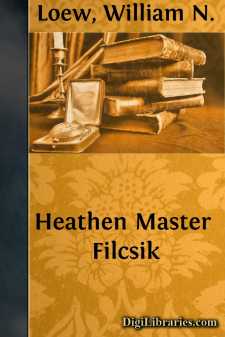Categories
- Antiques & Collectibles 13
- Architecture 36
- Art 48
- Bibles 22
- Biography & Autobiography 813
- Body, Mind & Spirit 142
- Business & Economics 28
- Children's Books 14
- Children's Fiction 11
- Computers 4
- Cooking 94
- Crafts & Hobbies 4
- Drama 346
- Education 46
- Family & Relationships 57
- Fiction 11829
- Games 19
- Gardening 17
- Health & Fitness 34
- History 1377
- House & Home 1
- Humor 147
- Juvenile Fiction 1873
- Juvenile Nonfiction 202
- Language Arts & Disciplines 88
- Law 16
- Literary Collections 686
- Literary Criticism 179
- Mathematics 13
- Medical 41
- Music 40
- Nature 179
- Non-Classifiable 1768
- Performing Arts 7
- Periodicals 1453
- Philosophy 64
- Photography 2
- Poetry 896
- Political Science 203
- Psychology 42
- Reference 154
- Religion 513
- Science 126
- Self-Help 84
- Social Science 81
- Sports & Recreation 34
- Study Aids 3
- Technology & Engineering 59
- Transportation 23
- Travel 463
- True Crime 29
Heathen Master Filcsik
by: William N. Loew
Description:
Excerpt
Through the kindness of William N. Loew, Esq., of the New York Bar, who has generously placed the manuscript at our disposal, we are able to offer a translation of one of the shorter stories by a living Hungarian writer.
The Magyar literature offers a mine of gold to the translator, but on account of the difficulties of the language very few have explored it. With the exception of the great novelist, Maurus Jókai, the works of the majority of the first class authors are unknown to the average American reader.
The difficulties of the Magyar tongue have been referred to. It is the one great literary language of Europe that is of non-Aryan origin. It is syllabic agglutinative, that is, the word inflections are made up by adding syllables to the root word that is never lost. The verb is particularly flexible and many of the tenses cannot be rendered adequately in English because they are constructed after a different system. The fine distinctions possible for the Magyar verb can only be felt, and not translated. This will explain the seeming inconsistency of the tenses in our story, where presents, futures, and perfects appear to be used indiscriminately, and yet the whole action has taken place in the more or less remote past. In this way the translator has endeavored to convey the vivid action of the original so far as the English verb system would allow him.
The author, Kálmán Mikszáth, is a follower of Jókai, but without the great master's originality. He has been called the "Mark Twain" of Magyar literature, and is looked upon by his compatriots as their leading humorist. He is a prolific writer of the feuilliton, that peculiar institution of the continental newspaper, and several collections of these have been published. Some of his works have been translated into English, but so far as could be learned, not this story of "Heathen Master Filcsik." His subjects are drawn generally from scenes relating to North Hungarian peasant life, and are told with a directness that makes the action move along rapidly. He also uses the folk lore in his works, the present tale being founded upon older material current in the country districts. Many of the details of his stories are left to the reader's imagination; he touches only the high lights, the shadows must be given form by the reader himself. His humor manifests itself in the most unexpected ways, even in this grim story of the unforgiving cobbler, there are touches of a sly, suggestive humor that brighten the otherwise sombre narrative.
Cleveland, Ohio,
March 17th, 1910.
Heathen Master Filcsik.
There is a foolish rumor current all over Csolt, Majornok and Bodok, that the famous fur cloak of old Filcsik is only a figment of his imagination. He speaks constantly of it; he boasts about it; he claims to wear it somewhere, but, as a matter of fact (so it is said) he has no fur cloak, and in all likelihood never had one.
Yet he did have one. The people of Gozon (he moved into our midst from beyond the Bágy) and especially the older ones recollect it well.
It was a long yellow cloak, with a wide collar of black lambskin from the two ends of which two lamb's feet were hung, hoofs and all, in their natural state. It was buckled in front by two beautiful silver clasps and in the corners below each clasp were embroidered two large green tulips....


